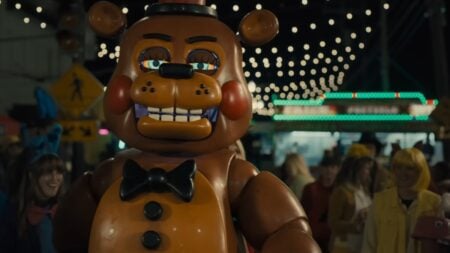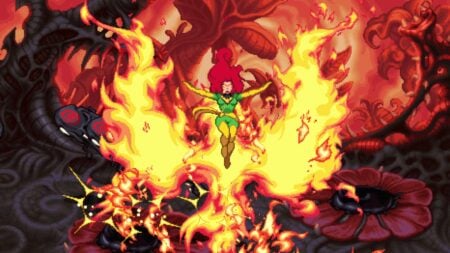Skip To...
Toying with a film’s genre in the middle of an established series is a bold move, but with A Haunting in Venice, it has definitely paid off. Agatha Christie’s Belgian detective Hercule Poirot returns in his latest outing, as played by Kenneth Branagh. Like last year’s Death on the Nile, A Haunting in Venice was directed by Branagh with a screenplay from Michael Green. This time, Poirot’s mystery is filled with terror, as he has trapped himself in a supposed haunted house after a supposed medium seemingly uncovers a killing.
A Haunting in Venice has a beginning that mirrors the first film, except instead of seeking a holiday, this time Poirot has retired in Italy. His peaceful time avoiding cases is interrupted by an old acquaintance of his, Ariadne Oliver (Tina Fey), who drags him to a Palazzo to confirm or debunk a medium’s abilities while she performs a séance. After Joyce Reynolds (Michelle Yeoh) “speaks to the dead”, the case kicks off, and Poirot locks everybody inside the Palazzo to investigate a death and to even solve the case of Alicia Drake (Rowan Robinson), who died on the premises much earlier.
The film has a smaller cast than Poirot’s previous adventures, at least in terms of star power. Joining Branagh are Kyle Allen, Kelly Reilly, Camille Cottin, Jude Hill, Riccardo Scamarcio, Ali Khan, Jamie Dornan, and Emma Laird. Kenneth Branagh is brilliant as Poirot, as he was in the previous two movies. Leaning on his character’s past to inform his performance, Poirot feels haunted here. While the rest of the cast is phenomenal for the most part, Jude Hill stands out as the young Leopold Ferrier, who was oddly off-putting and yet heartwarming at the same time.
Poirot’s Ghosts Come Back to Haunt Him
If you were expecting the movie to contain a couple of jump scares, a mystery, and nothing else, you might be surprised. A Haunting in Venice elaborately builds up an atmosphere of horror right from when Poirot enters the haunted Palazzo until the survivors exit at daybreak. It might actually be scarier than some modern horror movies, as Branagh knows when to hold back when to layer the film with spooky sounds, and when to suddenly change up the angles to put you in an anxious state. One sequence is filmed from Poirot’s perspective, putting us in his shoes and ramping up the terror.
The story itself is engaging and well-paced. Not having read Hallowe’en Party – the Agatha Christie novel on which A Haunting in Venice is loosely based – I did not unravel the full mystery until Poirot wrapped it up himself. That isn’t to say that there aren’t fairly obvious clues, clues that Poirot uses to wrap it up, rewarding the viewer for having a keen eye. With that being said, the film telegraphs who is going to be killed. It would have been good to be shocked when one of the colorful characters bit the dust.
The best parts of the previous films were learning about the cast of characters and seeing how their journey plays out. Most of the characters in A Haunting in Venice aren’t too interesting, with backstories that had me thinking about the case rather than their role in it. But, there are a few characters that stand out, especially Dr. Leslie Ferrier (Dornan), who suffers post-traumatic stress after his time in World War II. In fact, Poirot’s retirement and general moody demeanor in this film seem to be a reflection of his experiences during World War II as well.
Was There a Haunting in Venice?

One of the better elements of the movie comes from the main story point that Poirot is attempting to debunk the supernatural. Of course, the story of a detective not believing in the supernatural isn’t new, The Hound of the Baskervilles comes to mind. A Haunting in Venice did the trope justice by weaving in Poirot’s backstory, which has been peppered throughout the series of films. Much of the emotional throughline revolves around Poirot and his deceased love Katherine, which plays well in a horror setting.
An hour or so of the film’s 103-minute runtime is dedicated to Poirot questioning his own convictions regarding the supernatural and the great beyond. Branagh creates anxious moments through the scarier sequences, which are amplified by the brilliant score by Hildur Guðnadóttir. And even though some of the sequences recur, like the activation of a water tap, they are never boring. Unfortunately, the film lacks a strong companion for our detective, as Fey’s Oliver doesn’t hold a candle to Bouc, who in the previous films was played by Tom Bateman.
A Haunting in Venice more than proves that Branagh is capable of changing up the formula, something which Death on the Nile struggled to do. Because of this, I’d be glad to hear that more mysteries were in the works, even though nothing has been announced at this time. If you are a fan of the mystery or horror genres, feel free to go to the theaters and experience A Haunting in Venice for yourself.
A Haunting in Venice
An engaging story with an excellently executed horrific tone.
Pros
- An engaging story that will keep you guessing.
- Good performances that make you feel invested.
- The score and cinematography work together to create a deliciously horrific atmosphere.
Cons
- Poirot lacks an interesting companion.
- The deaths aren’t too much of a surprise because they are too heavily telegraphed.







